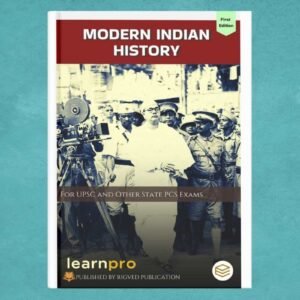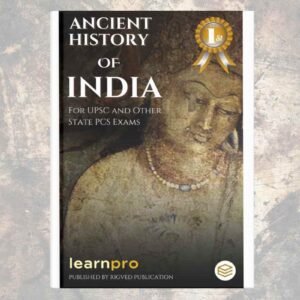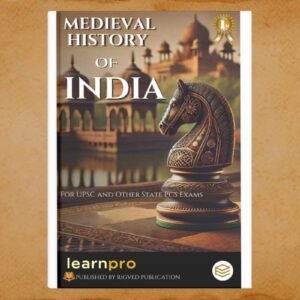Medieval History Notes for UPSC and State PCS Exams
Original price was: ₹399.00.₹159.00Current price is: ₹159.00.
These Medieval History Notes for UPSC and State PCS exams provide a structured, exam-focused resource covering the Tripartite Struggle, Delhi Sultanate, Mughal Empire, and regional kingdoms. Designed for Prelims and Mains, the notes comprehensively cover administration, economy, society, culture, religion, and Indo-Islamic architecture. With topic-wise clarity, easy recall points, and in-depth analysis, this resource is essential for mastering Medieval Indian History for UPSC and State PCS exams effectively
Guaranteed Safe Checkout
- Satisfaction Guaranteed
- No Hassle Refunds
- Secure Payments
Description
Medieval History Notes for UPSC and State PCS Exams
1. Early Medieval India (750 CE – 1206 CE)
The Tripartite Struggle (8th–10th Century)
- Conflict between Gurjara-Pratiharas, Palas, and Rashtrakutas
- Political fragmentation and regional power struggles
Regional Kingdoms
- Rajputs – Emergence of various clans (Chauhans, Parmars, Guhilots)
- Cholas – Rajaraja I, Rajendra Chola, administration, naval expeditions
- Chera and Pandya Dynasties – Influence in South India, trade links
- Western Chalukyas – Rule of Tailapa II, Someshvara I, and Vikramaditya VI
Society and Economy in Early Medieval India
- Feudalism – Samantas, local chieftains, land grants
- Agrarian Structure – Role of peasants, taxation, irrigation
- Trade and Urbanization – Decline of cities, rise of temple economy
Religion and Culture
- Rise of Tantrism – Esoteric Hindu and Buddhist sects
- Bhakti Movement – Alvars and Nayanars in South India
- Temple Architecture – Nagara, Dravida, and Vesara styles
2. The Delhi Sultanate (1206 CE – 1526 CE)
A. Slave Dynasty (1206–1290)
- Qutb-ud-din Aibak – Founder, construction of Qutub Minar
- Iltutmish – Chalisa (Turkish Nobility), introduction of Iqta System
- Raziya Sultana – First and only female ruler of Delhi
- Balban – Theory of Kingship, harsh military control
B. Khalji Dynasty (1290–1320)
- Jalal-ud-din Khalji – Founder, moderate policies
- Alauddin Khalji –
- Military campaigns – Expansion into Deccan
- Economic reforms – Market control, rationing system
C. Tughlaq Dynasty (1320–1414)
- Ghiyas-ud-din Tughlaq – Founder, policy of consolidation
- Muhammad bin Tughlaq –
- Administrative Experiments – Token currency, capital shift to Daulatabad
- Military failures, excessive taxation
- Firoz Shah Tughlaq – Irrigation projects, construction of canals
D. Sayyid and Lodi Dynasties (1414–1526)
- Sayyid Dynasty – Timur’s influence, weak administration
- Lodis –
- Ibrahim Lodi – Defeated in the First Battle of Panipat (1526)
E. Administration, Society, and Culture
- Iqta System – Decentralized administration
- Economy and Trade – Growth of markets, Persian influence
- Sufi & Bhakti Movements – Growth of composite culture
- Indo-Islamic Architecture – Tombs, mosques, and forts
3. Provincial Kingdoms and Resistance to Delhi Sultanate
North India
- Bengal – Independent sultans, trade with Southeast Asia
- Gujarat – Rich trading center, rise of Mahmud Begarha
- Malwa – Afghan and Rajput resistance
- Jaunpur – Sharqi dynasty, cultural development
- Kashmir – Hindu and Muslim rulers, emergence of Shah Mir
South India
- Vijayanagara Empire –
- Founded by Harihara and Bukka
- Peak under Krishnadevaraya – Military conquests, Amuktamalyada
- Bahmani Sultanate and Deccan Kingdoms – Five successor states
4. The Mughal Empire (1526 CE – 1707 CE)
A. Early Mughals (1526–1556)
- Babur –
- First Battle of Panipat (1526) – Defeats Ibrahim Lodi
- Battle of Khanwa (1527) – Defeats Rana Sanga
- Battle of Chanderi (1528)
- Humayun –
- Conflict with Sher Shah Suri
- Defeated at the Battle of Chausa (1539) and Battle of Kannauj (1540)
B. Sur Empire (1540–1556)
- Sher Shah Suri –
- Introduced the Rupiya system
- Constructed Grand Trunk Road
- Efficient administration – land revenue system
C. Expansion and Consolidation (1556–1605)
- Akbar –
- Second Battle of Panipat (1556) – Defeats Hemu
- Rajput Policy – Alliances and religious tolerance
- Din-i-Ilahi – Syncretic religion
- Mansabdari System – Military and administrative reforms
D. Mughal Golden Age (1605–1707)
- Jahangir – Nur Jahan’s influence, Persian conflicts
- Shah Jahan –
- Architectural advancements – Taj Mahal, Red Fort
- Expansion into Deccan
- Aurangzeb –
- Deccan Campaigns – War with Marathas
- Religious policies – Jizya tax reinstated
E. Mughal Administration, Society, and Economy
- Mansabdari and Jagirdari Systems
- Trade and Commerce – European trading companies enter India
- Mughal Art and Literature – Persian influence, Miniature paintings
5. The Rise of Regional States (1707–1761 CE)
Decline of Mughal Empire
- Causes – Weak successors, economic instability, invasions
- Rise of Marathas – Shivaji, Peshwa administration
- Third Battle of Panipat (1761) – Marathas vs. Ahmad Shah Abdali
Other Regional Powers
- Rajput States – Jaipur, Jodhpur, Mewar
- Sikhs – Guru Gobind Singh, Rise of Khalsa
- Jats – Bharatpur Kingdom
- European Powers – Portuguese, Dutch, English, and French presence
6. Religious and Cultural Developments in Medieval India
Bhakti Movement
- Alvars and Nayanars – Devotional hymns in Tamil Nadu
- Sant Kabir – Nirguna Bhakti
- Guru Nanak – Sikhism foundation
- Mirabai and Chaitanya Mahaprabhu – Vaishnavism
Sufi Movement
- Chishti Order – Nizamuddin Auliya, Khwaja Moinuddin Chishti
- Suhrawardi and Qadiri Orders – Spread of Sufism
Medieval Literature and Languages
- Persian – Akbarnama, Tuzuk-i-Jahangiri
- Hindi, Urdu, Sanskrit – Bhakti poetry
Indo-Islamic Architecture
- Mosques and Forts – Qutub Minar, Jama Masjid
- Tombs – Taj Mahal, Humayun’s Tomb
7. Economic and Social Developments
- Agrarian System – Zamindari, Jagirdari, Ryotwari
- Trade and Urbanization – Guilds, markets, European trade
- Social Structure – Caste system, position of women, education
8. Impact of Medieval History on Modern India
- Administrative Continuity – Mansabdari to British bureaucracy
- Legal and Revenue Systems – Mughal land revenue policies
- Architectural Legacy – Indo-Saracenic revival in colonial India




Reviews
There are no reviews yet.